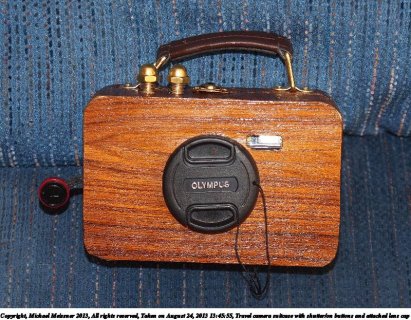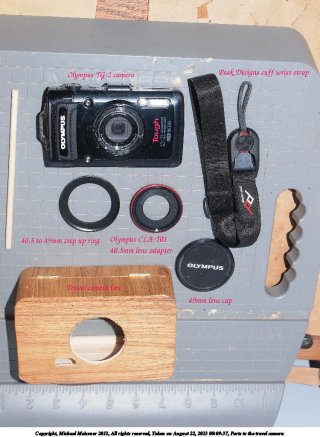MichaelMeissner
Senior Member+
What kind of material can be used with the touch sensor in the Teensy 3.0? I've seen some articles that describe using a processor without touch support built in, and an article here where Plocploc wanted to use a Sparkfun touch sensor, and Paul basically said it was made for normal analog read.
As some of you know, I like to make steampunk cameras. So far, the only use I've made of microprocessors, is to use a telegraph key to fire my large camera (that an earlier version is in my icon photo), and play 'Fire' on the buzzer in Morse code, but I'm starting to think more ambitiously.
My latest steampunk camera is embedding my Olympus TG-2 inside of a wooden box that looks like a suitcase that I got from a hobby store:


After seeings the discussion about NeoPixels, and that basic Teensy support is now encoded in the library, I just bought two Adafruit neopixel rings (http://www.adafruit.com/products/1463). Originally, I was just going to put them in goggles or some such, but when I looked at the size, it occured to me, I could mount one of them on the 40.5-49mm step-up ring that is part of my travel steampunk camera. What I would like to do is have the touch sensor hooked up to the brass 3/4" screw I have positioned over the shutter button as a mechanical button (this camera does not take shutter release cables, so I need to fire it mechanically), and when I touch the screw in preparation to fire the camera, either turn off the lights or turn them all onto white. When I release my finger, the Teensy would go back to doing whatever default pattern I set for the lights.
Now, I could use something like a force sensor, between the screw and the shutter button, but I think it might be cooler to have the sensor in the screw. If brass isn't conductive enough, I could change the screw to regular steel or something else. So, would the touch sensor in the Teensy be able to deal with a brass screw? If not, what kinds of things is the touch sensor designed for? I also would like to modify my telegraph key so that it begins focusing when I put my finger on the key (right now, it focuses when I have the key engaged, and when I release the telegraph key, it fires the camera).

As some of you know, I like to make steampunk cameras. So far, the only use I've made of microprocessors, is to use a telegraph key to fire my large camera (that an earlier version is in my icon photo), and play 'Fire' on the buzzer in Morse code, but I'm starting to think more ambitiously.
My latest steampunk camera is embedding my Olympus TG-2 inside of a wooden box that looks like a suitcase that I got from a hobby store:


After seeings the discussion about NeoPixels, and that basic Teensy support is now encoded in the library, I just bought two Adafruit neopixel rings (http://www.adafruit.com/products/1463). Originally, I was just going to put them in goggles or some such, but when I looked at the size, it occured to me, I could mount one of them on the 40.5-49mm step-up ring that is part of my travel steampunk camera. What I would like to do is have the touch sensor hooked up to the brass 3/4" screw I have positioned over the shutter button as a mechanical button (this camera does not take shutter release cables, so I need to fire it mechanically), and when I touch the screw in preparation to fire the camera, either turn off the lights or turn them all onto white. When I release my finger, the Teensy would go back to doing whatever default pattern I set for the lights.
Now, I could use something like a force sensor, between the screw and the shutter button, but I think it might be cooler to have the sensor in the screw. If brass isn't conductive enough, I could change the screw to regular steel or something else. So, would the touch sensor in the Teensy be able to deal with a brass screw? If not, what kinds of things is the touch sensor designed for? I also would like to modify my telegraph key so that it begins focusing when I put my finger on the key (right now, it focuses when I have the key engaged, and when I release the telegraph key, it fires the camera).
Last edited:

